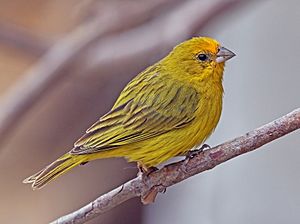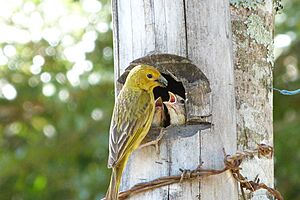Saffron finch facts for kids
Quick facts for kids Saffron finch |
|
|---|---|
 |
|
| Male, Brazil | |
 |
|
| Female |
|
| Conservation status | |
| Scientific classification | |
 |
|
| Synonyms | |
|
Fringilla flaveola Linnaeus, 1766 |
The saffron finch (Sicalis flaveola) is a bright yellow bird from South America. It's often called a "canary" because of its cheerful song and sunny color. But it's important to know that it's not actually related to the true Atlantic canary. These birds are common in open areas and grasslands. You won't usually find them deep inside the Amazon Basin.
Saffron finches live in many countries. Their home includes Colombia, Venezuela, Ecuador, Peru, Brazil, Bolivia, Paraguay, Uruguay, and Argentina. They also live on the islands of Trinidad and Tobago. People have also brought them to places like Hawaii, Panama, and Puerto Rico.
Contents
About the Saffron Finch
The saffron finch is a type of tanager. Scientists used to think it was a kind of bunting. But now they know it's more closely related to seedeater birds.
What Does a Saffron Finch Look Like?
Male saffron finches are easy to spot. They are a bright, sunny yellow color. They also have a special orange patch on top of their head. This orange patch helps tell them apart from other yellow finches.
Female saffron finches are a bit harder to identify. They are usually a duller yellow than the males. But in some places, like southern South America, females can look very different. They might be olive-brown with dark streaks on their feathers.
Saffron Finch Reproduction and Nests
Saffron finches like to build their nests in cozy, hidden spots. They often choose cavities or holes. This could be an old nest made by another bird, like the rufous hornero. They also like to nest in hollow bamboo branches. Sometimes, they even build nests under the roofs of houses. This shows they don't mind living close to people. You might even see them visiting bird tables in suburban areas.
These birds have a pleasant song, even though it can be a bit repetitive. Because of their pretty song and bright looks, many people keep them as pet birds. Male saffron finches are known to be polygamous. This means one male might mate with two different females during the nesting season. They are also very territorial. This means they will protect their space from other male finches. Sometimes, people put two males in a cage together. This is to watch them fight over territory.
Images for kids



